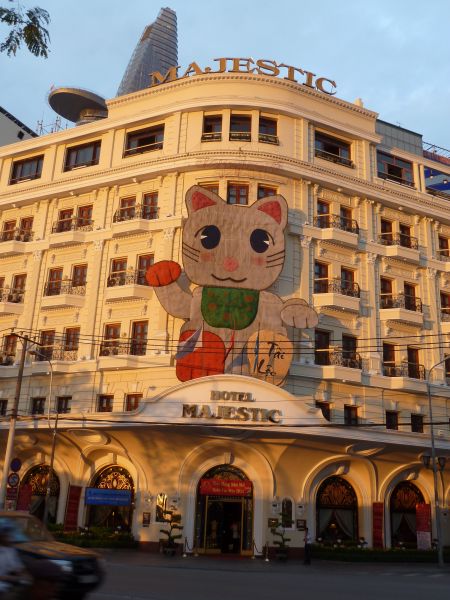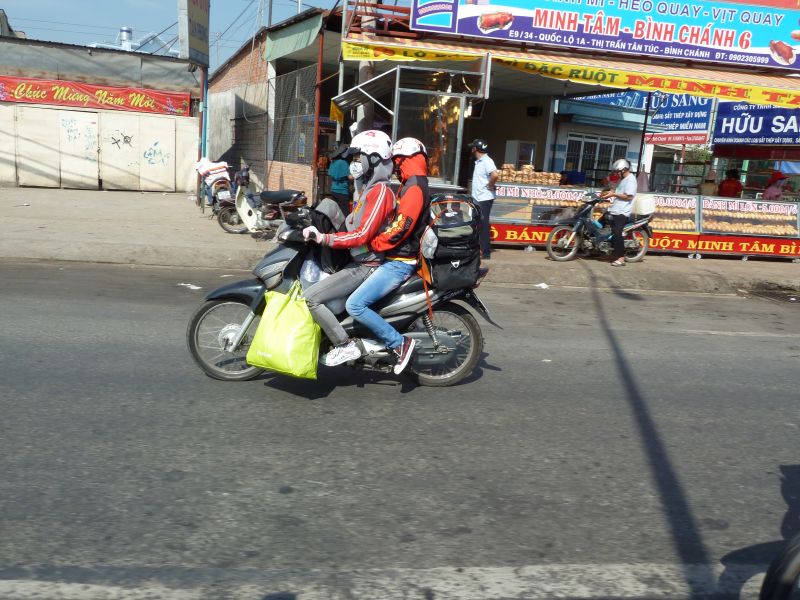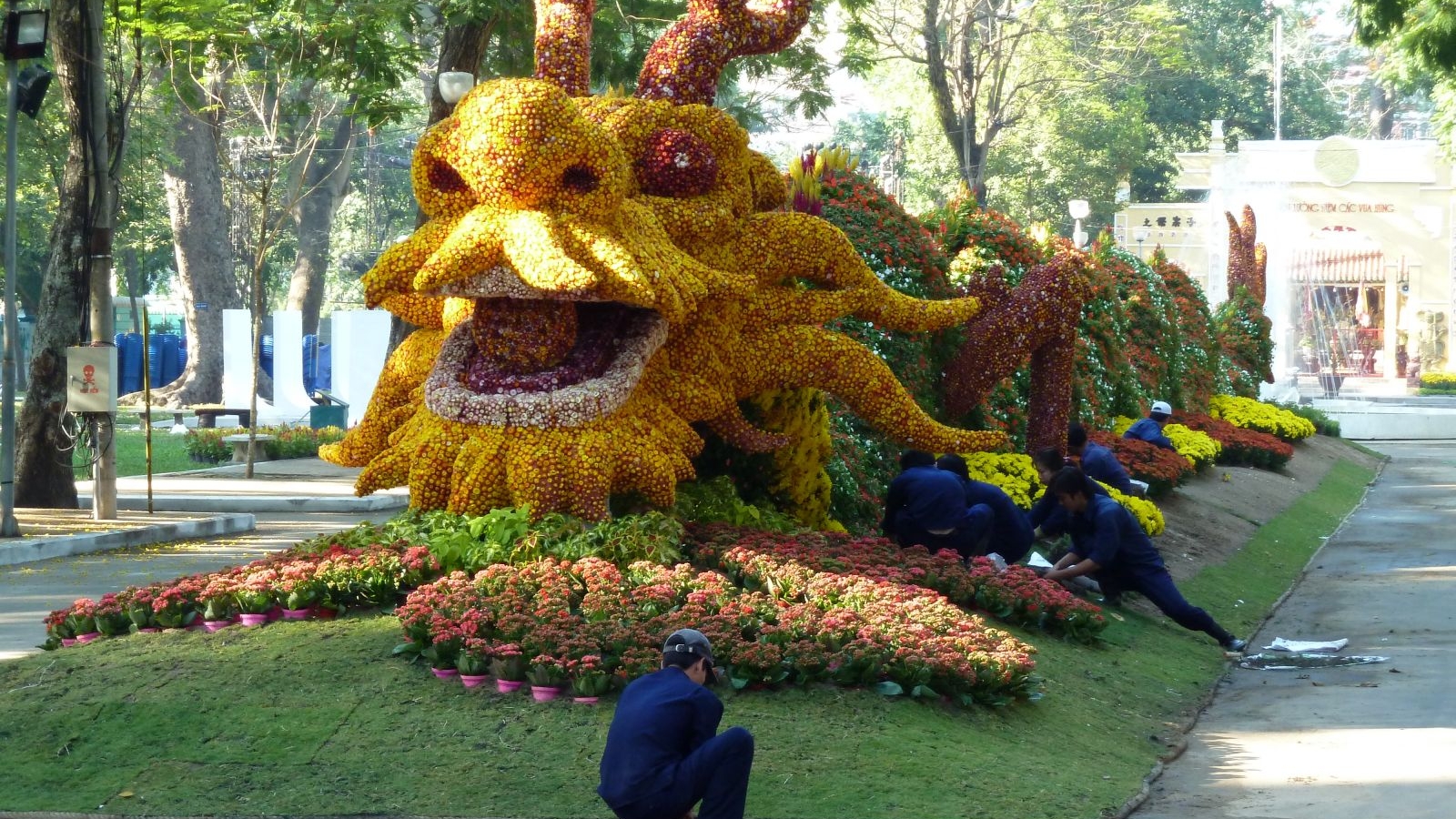[Above: Workers put finishing touches on a huge dragon made of flowers in a downtown Saigon park for the Vietnamese New Year, or Tet, and the Year of the Cat.]
By Carl Robinson
SAIGON—Since I walked off that French freighter from Hong Kong back in early 1964 on the eve of the Vietnamese New Year, Tet has always held a very special place in my long association with Vietnam. With early dry season blue skies, a gentle breeze and even a slight chill in the air, Tet is surely the best time of year in southern Vietnam. The rice crops are in and the mood is festive. Homes are cleaned and repainted, and family altars stocked up with delicacies and flowers. Tangible anticipation fills the air.
For foreigners in Vietnam, Tet can be a dreadfully lonely time. All businesses, including most restaurants and bars, close down for a week or 10 days, and hotels, especially those here in Saigon, or what the communist leadership in Hanoi insists on calling Ho Chi Minh City, are barely turning over as Vietnamese gather with families and friends to celebrate the new lunar year. During the Vietnam War, Tet was almost always a time of truce which, combined with cease-fires around Christmas and New Year, always provided a surreal month-long break from the fighting.
Back here on this long-awaited occasion, it’d be easy to remark how Tet has gone all commercial, like our own Christmas and other holidays. But the spirit behind Tet is stronger than ever and illustrates how the Vietnamese have not lost their long-held rituals and traditions. At heart, Tet is still a family festival and, of course, the flowers, fruit and food must be perfect. In Saigon – and even out into the smallest village – colourful flower and fruit markets have sprung up. Marigolds, chrysanthemums, lilies, sun flowers, orchids and other tropical flowers, all in lovely pots. Vietnamese love their bonsai and the must-have purchase is a potted Tet Flower with its delicate yellow blossoms, a genuine Vietnamese emblem, for which they’ll put up to $500. If you are truly lucky, the first bloom will pop out on the first day of the new year. Watermelons, including yellow ones, grapefruit-like Pomelo and Vietnam’s unique Dragon Fuit are the most popular altar fruits. Food stores are busy selling Tet-oriented delicacies with the most prized “banh chung,” a glutinous rice and pork fat cake wrapped in banana leaf with its legend dating back to Vietnam’s own Bronze Age 3,000 years ago.
And the vicious circle way the Vietnamese do things, people are making and spending money. Even in these tough economic times, workers got their Tet Bonus – an extra month’s wages – which they’re clearly spending. The money is shared around and extra tips part of the season. After all, you can’t get those potted flowers home without help from a friendly pedicab or pickup driver. Everywhere you look in traffic, everyone is lugging home something for Tet. And then just the past couple days, the whole country is on the move. Planes, buses and trains booked solid. More modest travellers pile everything, including the kids and the suitcases, onto one motorbike. All have the same goal—to be with their families for Tet.
Of course, Vietnam—still a Limping Tiger—has its problems. Its economy is staggering along with high inflation, a weak currency and poor balance of payments, to say nothing increasingly obvious human rights abuses and moribund one-party system. But those details are for another occasion and, again, one must not speak ill at Tet.
My First Tet
My hosts on my first Tet nearly a half century ago were a number of Vietnamese university students at the heart of opposition to President Ngo Dinh Diem who’d been overthrown and assassinated only a couple months before. So the mood was still hopeful and I was blessed with an early introduction into the rituals of this holiday. Those little red envelopes of brand-new money for the kids. Sipping fragrant tea while nibbling on preserved fruit, dried lotus seeds and jellied candies. But I never quite mastered the delicacy of cracking open those dyed-red watermelon seeds with my front teeth.
Tets—if I may use the plural—became even more meaningful when, later on, I fell in love and eventually married the prettiest girl in the Mekong Delta province where I was posted with the U.S. aid mission. (At least I won one heart, but not necessarily a mind.) We were together at Tet 1968 when just about every other province capital in South Vietnam was attacked. But nothing happened in Go Cong Province. With all roads and flights cut, I was stranded for a week. When I finally resurfaced at USAID headquarters, I angrily resigned, sick and tired of their never reading our reports and the enforced optimism that only weeks before had heralded General William Westmoreland’s famous Light at the End of the Tunnel. I joined the “enemy”—the Saigon press corps.
But from marrying into Vietnam, I learned even more about Tet and its importance in preserving family which is ultimately even stronger than country. The Kitchen God, for instance, is farewelled a week before Tet to report who’s been naughty and nice to the Jade Emperor and then returns right on the eve of the new year. In the post-midnight silence, we listened for the sound that would be the omen for the year ahead. And most importantly, I learned to be very careful what I said and did on the First Day of Tet. Never speak ill or be angry then—or you’ll ruin the rest of the year.
After that angry and bloody outburst by the Viet Cong and North Vietnamese at Tet 1968, the Vietnam War returned to its uneasy stability and tenuous truces. But we were much more leery now. Fireworks were banned so no one would make that mistake again. And, even when I had to pop right back to my news bureau in Saigon, how I treasured those last-minute Tet Eve dashes down to the Mekong Delta to join the family gatherings. In the now-forgotten Tet of 1974, the Chinese grabbed the Paracel Islands off the South Vietnamese without its ally Hanoi raising a whimper, an ironic contrast to today’s on-going dramas over the disputed islands off central Vietnam. And then came my last Tet before the fall of Saigon in 1975 when I made an after-dark dash—never highly-advised—to join the family in the Delta one more time.
Then, suddenly cut off from Vietnam and family, Tet turned totally opposite to deep sadness first in the United States, then Australia where we settled permanently. It would be a dozen years before the family was together again. Over the past 15 years, we’ve returned to Vietnam many times—in fact, it’s almost a commute—but never for Tet. Finally this year, we’ve returned for our first Tet back since the end of the Vietnam War.
However, as Vietnam heads into what’s known here as the Year of the Cat (not the Chinese Rabbit), it is worth recalling that the main goal of the Tet 1968 offensive, engineered of course by the eventual winner of the Vietnam War, was to provoke a general uprising. That didn’t happen and it’s unlikely even today—though there is the suggestion, quite widely spread these days, that the still most autocratic bosses in Hanoi are keeping a close, perhaps even nervous, eye on the fate of that far-off autocrat in Egypt. But for the moment, everyone’s just too busy with Tet to give that too much thought.
*****
*****

Saigon's famous river-front Majestic Hotel displays its gigantic tribute to Vietnam's Year of the Cat.
*****

By whatever means, getting home is everyone's highest priority at Tet, the Vietnamese New Year, and here a couple young women – totally rugged up for sun, wind and pollution – head out of Saigon on their totally loaded-down motorbike, the country's most popular form of transport.
Carl Robinson runs the Google Group “Vietnam Old Hacks” of former correspondents and others who worked in South Vietnam during the war. Living in Australia since the war, he is also the author of Odyssey’s Mongolia: Nomad Empire of Eternal Blue Skies and runs tours to there and Vietnam.
